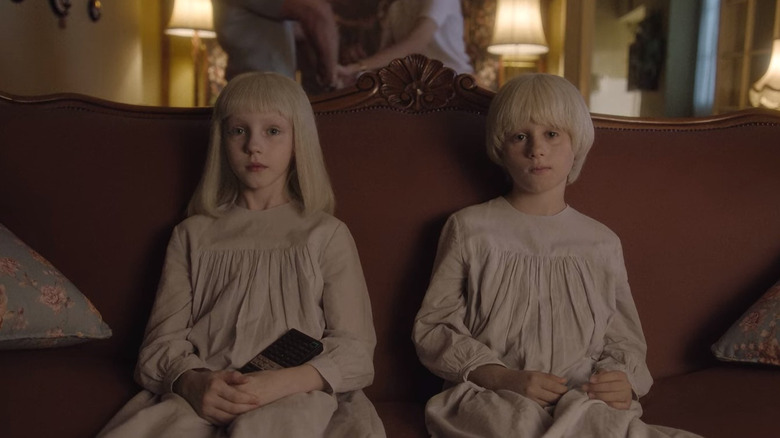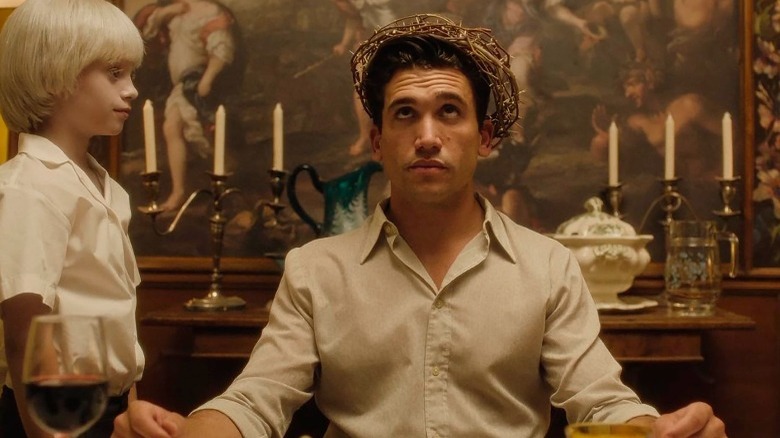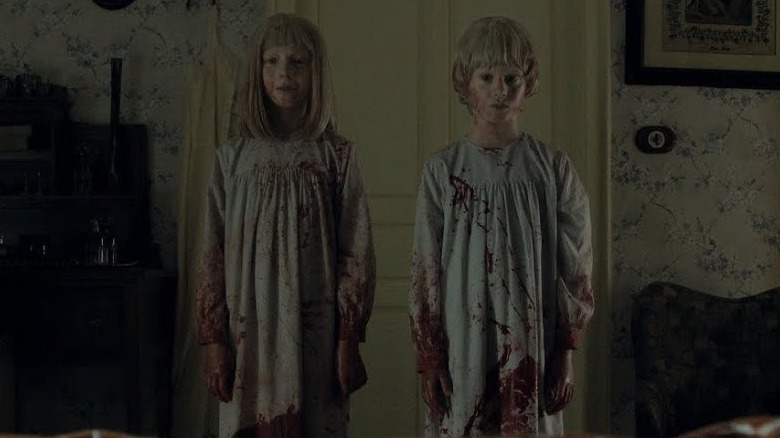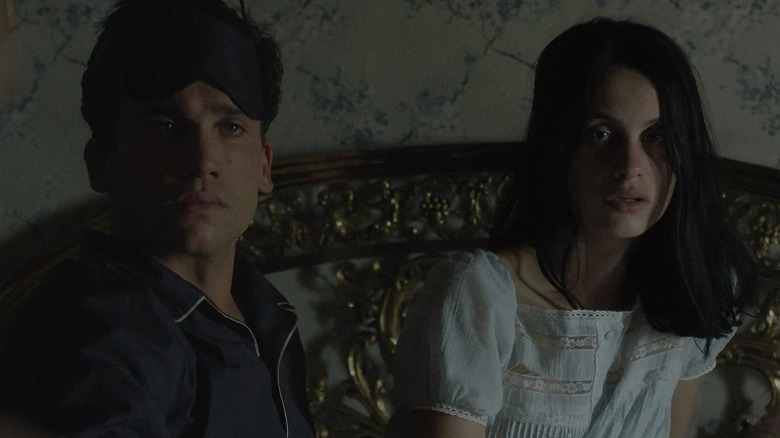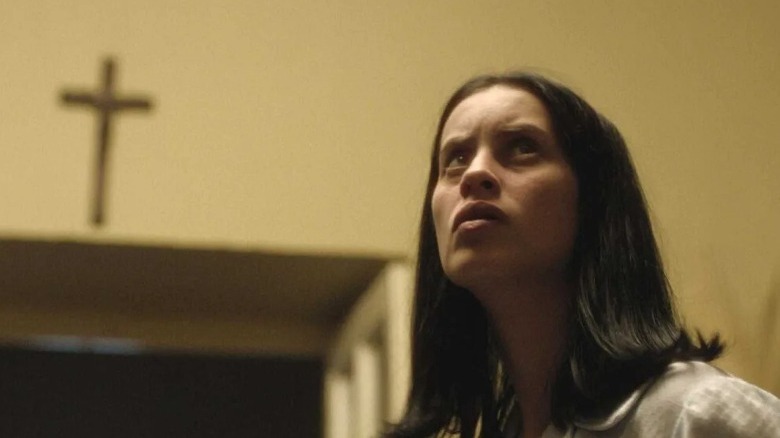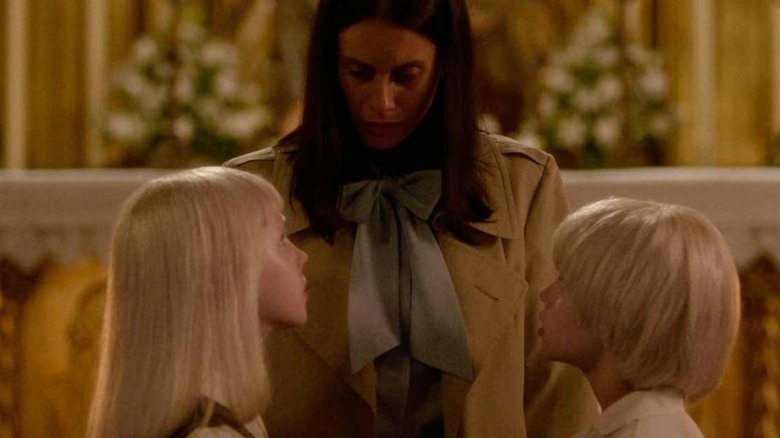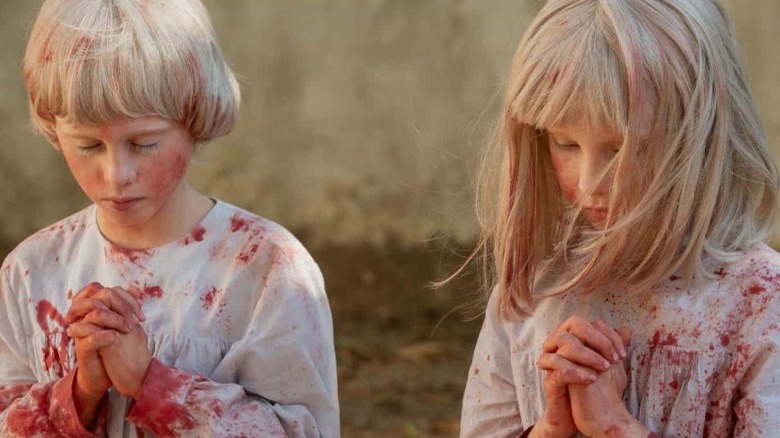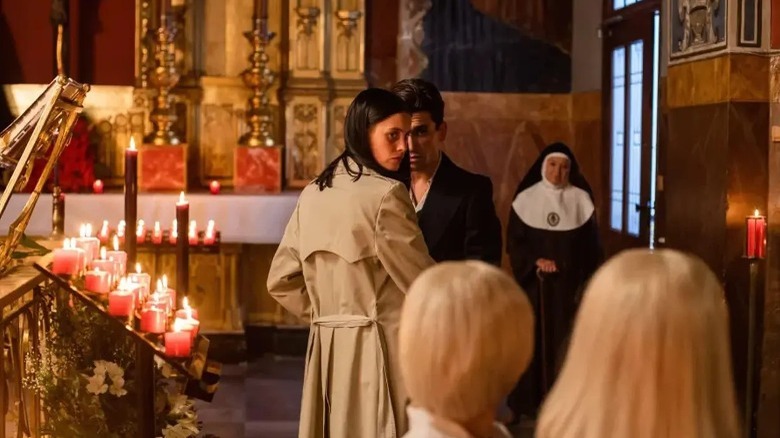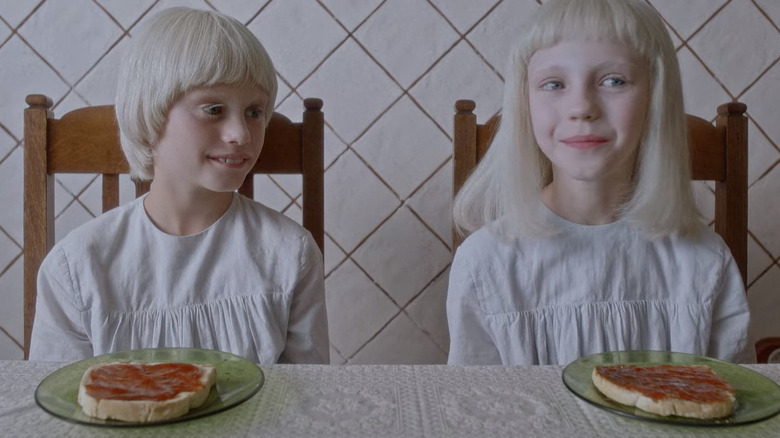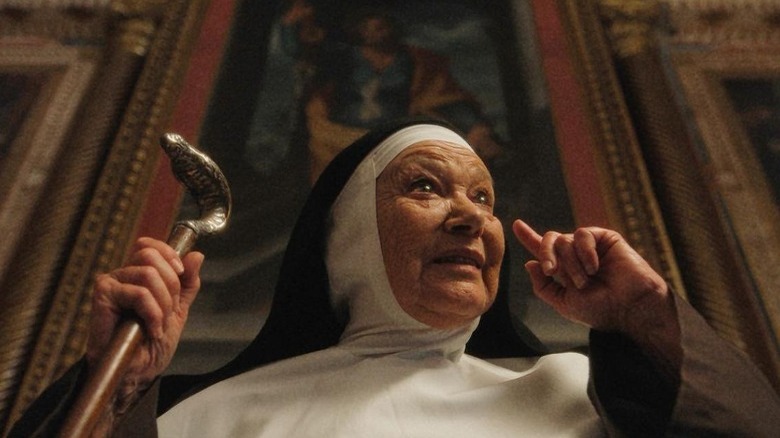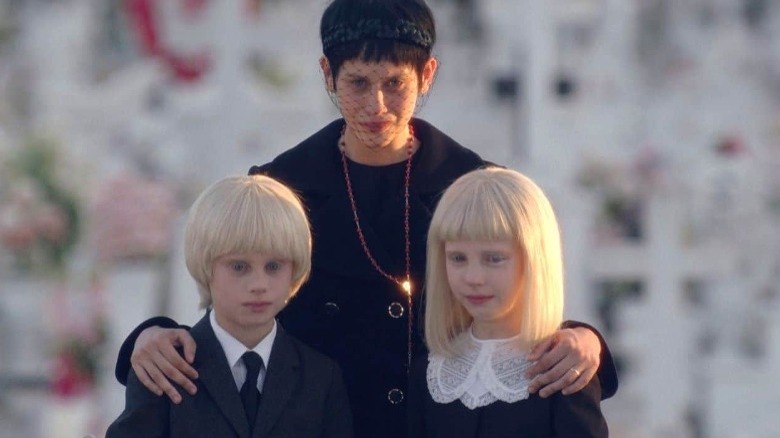The Ending Of Tin And Tina Explained
Contains spoilers for "Tin & Tina"
It's not often that a scary movie flop can defy the odds and find mass appeal with a wide audience, but "Tin & Tina" is not your standard campfire tale. The movie pairs creepy twins with religious horror to create an experience that will continually shock you as you watch it and will stick with you long after the credits roll. It may have suffered with critics, but writer-director Rubin Stein's debut is one of the best horror movies streaming right now.
The movie somewhat channels "The Shining" as it makes its centerpiece the titular twins, religiously-obsessed children who have some unique ideas about what is right and wrong, and how those morals should be expressed. Played by Carlos G. Morollón and Anastasia Russo, the twins are by far the creepiest part of the movie, but the horror is really sold by their adoptive parents (Milena Smit and Jaime Lorente), who have no idea what they're getting themselves into when they welcome Tin and Tina into their home.
Like the rest of Netflix's best psychological thrillers, "Tin & Tina" is a thrilling ride that lets its most terrifying moments take place in your imagination. Between all the obscured motives and deep religious imagery, the movie is begging its audience to ask questions — but we've already taken care of that and asked them all for you.
What you need to remember about the plot of Tin and Tina
Like many good horror stories, "Tin & Tina" begins in a happy place. The movie opens with Lola and Adolfo getting married, and the two of them seem overjoyed to be starting their lives together. That joy quickly fades when Lola starts bleeding through her wedding dress and needs to be rushed to the hospital. It turns out that she was pregnant, and some unexplained complications not only cost the baby's life but also prevent her from getting pregnant again.
Eventually, Lola and Adolfo consider adopting to keep their dream of having a family alive and to get their relationship back on track. They go to the Convent of Saint Augustine and meet Tin and Tina while the kids are playing the organ. Adolfo is a little put off by the twins, but Lola becomes attached to them immediately and begs her husband to bring them home.
It becomes clear pretty quickly that Tin and Tina are unusual kids. They were raised by the nuns at the convent, and they have some intense obsessions with God and the Bible. Lola and Adolfo aren't religious themselves, but they try to start praying at meals to make the kids feel welcome. It's not enough. The kids are extremely concerned with punishing wrongdoing, and when the family dog bites Lola, Tin and Tina kill it. As you might imagine, things start going downhill pretty fast from there.
What happens at the end of Tin and Tina
Towards the end of the movie, Lola discovers that she's pregnant. Tin and Tina insist that her new baby is a miracle, and though Lola doesn't wholeheartedly agree with them, she starts opening up to their point of view. Then the baby is born and a new disaster strikes. Lola refuses to let the baby be baptized, so the twins take matters into their own hands. They perform a baptism in the family pool and nearly kill the baby boy in the process. At that point, Adolfo insists that he and Lola return the twins to the convent.
It doesn't take long for Lola to feel guilty about what they've done. One night she tells Adolfo that she can't handle the guilt, and that she's thinking of ending their marriage. Distraught, Adoflo goes upstairs to comfort their baby just as a storm rolls in and cuts the power to their house. A few minutes later Adolfo falls from the balcony, his entire body set ablaze. As the house begins to burn down, Lola prays to find her son in time to escape, and she does. In the morning Sister Asunción tells Lola that the twins were at the convent the entire night and couldn't have possibly hurt Adolfo. Believing that the twins must have been innocent the entire time, Lola takes them back, and they start a new family together.
What is the significance of the historical context?
The historical placement of "Tin & Tina" doesn't have any immediate impact on the plot, and the movie spends so little time exploring it that it'd be easy for some viewers to entirely miss what's going on. Despite that, the movie is set during a very particular time period in Spanish history.
The film opens with Adolfo and Lola getting married in 1981. That same day Lola is rushed to the hospital, and just as she learns that she's lost her baby, Adolfo sees on TV that a coup is being attempted in the Spanish parliament. In February of that year, Lieutenant Colonel Antonio Tejero Molina attempted to overthrow the Spanish democracy. It didn't work out well at all, and by September, Lieutenant Molina was arrested along with the men who helped him, and the coup was squashed.
When Lola finds herself back in the hospital after Adolfo has been burned alive, the TV is playing a news broadcast announcing the end of the coup. The film is bookended by these historical updates, but what they mean for the larger story is debatable. Does marriage to Adolfo represent a coup in Lola's life? Does the collapse of the coup represent the overwhelming power of God that Tin and Tina talk about? It could simply be a reflection of the disruption and chaos that occurs in Lola's life during the course of the movie. Viewers will have to interpret this for themselves.
Does St. Augustine have a deeper meaning?
The historical Saint Augustine is hardly mentioned in the film, but his presence overshadows everything that happens. Saint Augustine is the namesake of the convent where Tin and Tina were raised, and of course, he's also the namesake of the twins themselves. He's not exactly a pop culture figure, but he's one of the most important saints in Christianity.
Saint Augustine lived from the year 354 to 430, and he served as the bishop of Hippo for more than 30 years of his life. A prolific writer, Augustine produced millions of handwritten words detailing his thoughts on God, life, and the Christian religion. His books "The City of God" and "Confessions" massively influenced medieval Christian practice, and they still inform much of the philosophical thinking behind Christianity today.
Maybe having Saint Augustine as a namesake dictated Tin and Tina's fate. Like Augustine, the twins are devout Christians with well-defined views on what is right and wrong, and just like Augustine, the twins want to find a way to transmit their views to the world around them. Unfortunately, neither Tin nor Tina has any literary inclinations, and they prefer to make their thoughts known with the point of a knife or a spoonful of poison. Maybe their convent wasn't big on teaching healthy methods of communication.
What is the importance of the baptism scene?
There are several gruesome and violent scenes in "Tin & Tina," and compared to them, the baptism scene can be considered subdued. The understated presentation of the scene perfectly balances its actual weight in the story. It's far and away the most impactful moment in the entire movie, and the various interpretations of the scene have a huge impact on the overall meaning of the film.
The baptism scene is the first time that we get to actually watch Tin and Tina as they do something that's potentially evil. They were hidden behind the couch when they murdered the family dog, and whatever happened to their schoolyard bully occurred entirely off-screen. This time we catch them in the act, and they probably don't look like most viewers imagined. The twins aren't gleeful or even overly mischievous while baptizing their brother. They actually seem to be intently focused on what they're doing, and when Tina says they need to keep the baby underwater for a long time to cleanse his soul, she seems to actually believe that sentiment.
This scene, more than any other, introduces some doubt about whether or not the twins are actually evil. This is the one time where their potentially destructive religious practices could honestly be interpreted as childish misunderstandings. It's ironic that this is the one moment that actually tears their entire family apart.
Does the short film impact Tin and Tina's meaning?
Rubin Stein is the writer-director behind the movie, and he based this feature film on a previous short film he created also titled "Tin & Tina." Like the feature, Stein's short was about a pair of religion-obsessed twins who end up committing unspeakable acts in the name of their faith. The content of the two projects is very similar, but the presentation of each is wildly different.
The short film was shot entirely in black and white. The film played with the idea of light versus darkness both in its themes, and the way it framed its action. The full short film was also done in one shot, so viewers never got a break from the action and were forcibly sucked into the horror unfolding on their screens.
Some of the short film's stylistic moves were eventually translated into the feature-length project. In both versions of the story, the twins kill a dog, but their brutal murder of the animal is obscured by a couch in the living room. Hiding the specifics of the action forces viewers to imagine what's going on, and imagination is almost always worse than reality when it comes to horror. The climax of the feature film, when Adolfo and Lola nearly break up just before their house burns down, is also filmed in one shot, harking back to the original project.
Could there be a sequel?
It'd be easy to say that no, there could never be a sequel to "Tin & Tina." After all, the story is basically resolved by the end of the film. Adolfo has tragically died, but his death has led Lola to reunite with the twins. She's going to go on raising them as her own alongside her biological son.
The immediate conflicts introduced in the movie might be resolved, but there are plenty of lingering questions that could be explored in a follow-up film. A sequel could continue playing with the question of Tin and Tina's guilt. It could also show whether or not Lola fully commits to religion like the twins want, and it could explore the process of the twins working together to influence their younger brother.
If Ruben Stein wanted to, he could absolutely come up with another story that would fill an entire movie. Tin and Tina are excellent fodder for horrifying situations, and it's easy to imagine their terrifying actions getting worse as the two of them get older. Besides, it wouldn't be the first time that an apparently buttoned-up story gets expanded on. For now, fans of the film will just have to cross their fingers and hope for more to come.
What has Milena Smit said about Tin and Tina?
There are a number of great performances in "Tin and Tina," but the film wouldn't be nearly as enthralling without Milena Smit, who played Lola. Smit's character is the real heart of the film, and it's her emotional journey that carries viewers from the beginning of the story through to the disturbing end.
In an interview with The Envoy Web, Smit shed some light on Lola and what attracted her to the role in the first place. She said that Lola embodies a complex mix of strength and fragility, because she so desperately wants to have a family, but at every turn, she doubts whether or not her dream life is really possible. "For me, it was a challenge to show that duality of the character at all times," Lola said.
Smit rose to the challenge, and she not only captured that duality for herself but also transmitted it to the audience. The real tension of watching "Tin and Tina" is not wanting to believe that Lola's adopted children could be so violent and potentially evil. The more we hope the worst isn't true, the more scared we feel that it must be.
What has Rubin Stein said about the film?
Rubin Stein is the filmmaker behind shorts like "Handsome Devil," "Nero," and "Bailoraora." He wrote and directed the original "Tin & Tina" as part of a trilogy he called "Light & Darkness," and he took on the same roles when it came to adapting the short film into his first feature-length movie. We've already talked about how Stein translated some of his filmmaking techniques from the short to the feature, but the director himself has talked about how the impulse behind both versions of the story came from the very same place.
In an interview with Moobys, Stein opened up about his drive to make "Tin & Tina" and how the film related to his childhood. He said that when he was a young boy his aunt introduced him to Christianity. He understood that she wanted to do something good by exposing him to religion, but even though he was fascinated by what he learned, part of him was also deeply disturbed by some of what he heard about life and death.
That combination of fascination and fear is what Stein wanted to capture with "Tin & Tina." Lola's complicated relationship with religion in the movie is probably a bit reflective of Stein's own experience, and the movie itself forces the audience to take a look at the darker side of Christianity that first captured Stein's attention as a child.
What if Tin and Tina really were innocent?
What if "Tin and Tina" is really a sweet movie about traumatized people coming together and forming a family? While watching the film it's hard to imagine that the titular twins are anything but evil. Any character who kills a dog is going to be instantly reviled, and there's no denying the twins did that. If we can set aside that initial impulse, though, it's possible to imagine a version of the film where the twins really are misguided, innocent children.
Tin and Tina were raised in the convent, and they grew up under the watchful eye of Sister Asunción. The film makes it abundantly clear that she's a harsh authority figure, and she's definitely a believer in a "fire and brimstone" version of Christianity. The twins absorbed Sister Asunción's teachings, and it may have deeply scarred them.
After killing the family dog, there's no hard proof of the twins doing anything harmful. Lola thinks they're poisoning her, but that turns out to be a mistake. Their bully gets injured and put in a coma, but we can't be certain the twins had anything to do with that. When Adolfo dies, we don't see the twins, and Sister Asunción claims they were at the convent the whole time. If the twins really are innocent, then the ending of the movie is actually kind of sweet. That said, we'd stay on the cautious side and wouldn't commit any mortal sins in front of Tin and Tina anytime soon.
